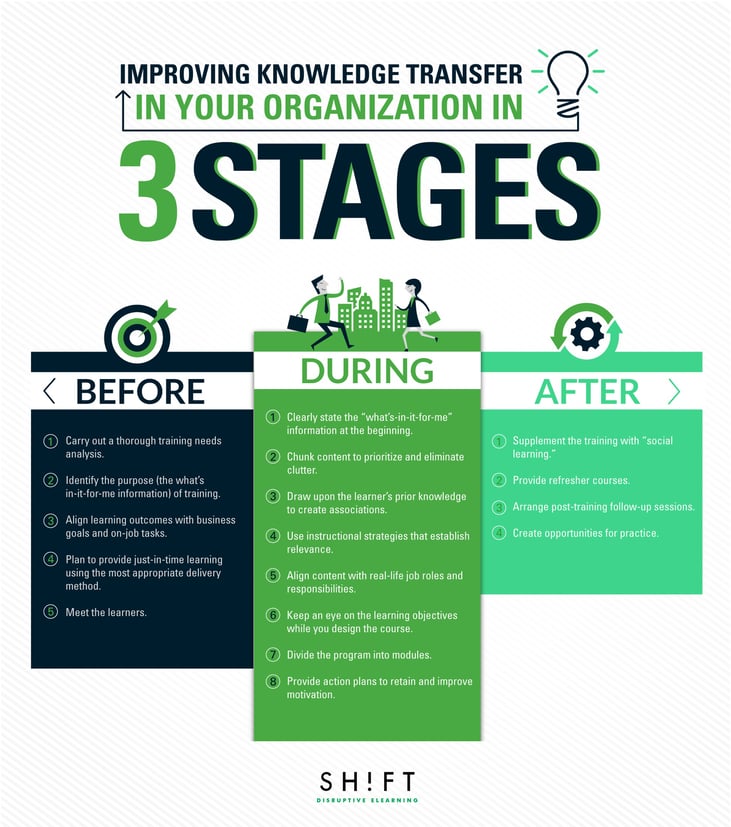So, you've got a burning desire to see your employees flourish and apply their newfound knowledge to tackle real challenges at work. You've invested time, money, and effort into their training, and you're not just looking for your employees to sit back and regurgitate information. Nope, you want them to roll up their sleeves, get their hands dirty, and put what they've learned into action!
But let's face it, transferring learning isn't as easy as snapping your fingers. Research shows that throwing in flashy content doesn't always guarantee the knockout effect we crave.
You see, humans are wonderfully complex creatures, and each individual is unique. It's like trying to predict the weather – what works like a charm for one person might be a tough nut to crack for someone else. And just because someone gets the concept during training doesn't necessarily mean they'll nail it when it comes to a real-world problem.
The sad truth is that a whopping 90 percent of training programs lack a well-defined strategy to make learning transfer happen smoothly.
Now, don't worry; it's not all doom and gloom. There are a bunch of other factors that can influence how effective the learning transfer process is. That's where this article comes into play. By diving in, you'll discover the key variables you're working with, which will help you design way more effective eLearning programs.
As a savvy training manager and course designer, you've got to aim for a comprehensive learning experience. And remember, learning isn't confined to the training session alone. Nope, it's an ongoing journey that spans before, during, and after the training – you've got to cover all bases to ensure success.
So, buckle up, and let's dive into the nitty-gritty of learning transfer.

Before the Training
You can facilitate a glitch-free learning and transfer process by adopting these measures even before the training program starts.
1) Carry out a thorough training needs analysis.
To ensure your employees excel in their job responsibilities, we need to start with a thorough training needs analysis. This exercise is all about diving deep and figuring out exactly what skills and knowledge they need to shine and identifying any gaps in their current know-how.
By conducting this comprehensive training needs assessment with your trainees, you'll gain valuable insights that will guide you in designing top-notch eLearning courses. These courses will have relevant content tailored to address the specific needs of your learners, helping them perform at their absolute best in their roles.
So, here's the plan: Reach out to your audience, get them involved, and have them fill out self-assessment forms. This way, they'll actively identify the skills they already possess and pinpoint the knowledge and training areas they want to improve on. With this knowledge in hand, we can craft eLearning experiences that'll truly make a difference! Let's get started and watch your team soar to new heights! 🚀
Also read: DON'T Skip the Training Needs Analysis! Here's Why.
2) Identify the purpose (the what’s in-it-for-me information) of training.
Identify the training goals and learning objectives before you start designing the course. This ensures that all team members are on the same page, work towards a common goal, and focus their efforts to achieve similar objectives. Identifying the training goals right at the outset also sets audience expectations; they know what the training will be on and what learning outcomes they can expect.
3) Align learning outcomes with business goals and on-job tasks.
To supercharge your team's learning experience, it's essential to align those learning outcomes with your business goals and on-the-job tasks.
Here's the game plan: Make a crystal-clear connection between your company's overarching business goals and the specific skills your learners will acquire throughout the course. When your team sees this clear association, it becomes a powerful motivator. They'll understand exactly what they're working towards and how their newfound abilities will contribute to the company's success.
Recommended read: 5 Steps to Design eLearning That Meets Business Goals
4) Plan to provide just-in-time learning using the most appropriate delivery method.
To ensure that your training has the maximum impact on learners, provide training just when they need it. For instance, sales reps need to access a course on the last update on a product when they are at the store in front of the client. Just-in-time training has the maximum impact because learners can apply the knowledge they have acquired right away.
To provide just-in-time training, consider the following tips:
-
Identify different content for different groups of people based on their existing skills and career paths.
-
Choose the right delivery method for your target audience.
-
Create opportunities for learners to access the training whenever, wherever they are. Read more about responsive eLearning.
5) Meet the learners.
Let's make those learner connections count! As managers, it's crucial to meet with some of your audience before the training kicks off. Take the time to engage with them personally and emphasize the importance of the material they're about to dive into. Show them how the learning outcomes directly align with the company's grand vision and how this knowledge can propel their careers forward.
When you meet with the learners, it's a chance to spark motivation and excitement. They'll see that their growth is intertwined with the success of the company, creating a powerful sense of purpose.
Also read: These 27 Questions Will Help You (Really) Know Your Learners
During the Training
You have to ensure that the eLearning course communicates meaning efficiently and creates a memorable learning experience. Here’re some ideas:
1) State the “what’s-in-it-for-me” information at the beginning.
The savvy learner asks the golden question, "What's in it for me?" And as eLearning designers, we need to be ready with a compelling answer.
Here's the scoop: Research by Kontoghiorghes shows that learning transfer happens more effectively when learners are aware of the specific behaviors they're expected to demonstrate after completing the training. To make this magic happen, we must kick things off with clear and well-defined learning objectives.
Right from the beginning, we lay out what learners can expect to achieve from the course. This sets the stage, manages expectations, and removes any uncertainties. When they know exactly what's in store, learners are more engaged and motivated to dive into the material.
2) Chunk content to prioritize and eliminate clutter.
Chunking and prioritizing content is key to keeping your course focused, clutter-free, and highly relevant. Let's make sure our adult learners get the most out of their valuable time by delivering a course that cuts to the chase right from the start.
Here's the secret sauce: As you chunk the content, keep a close eye on the learning objectives. Focus solely on the "must-know" information that directly addresses these objectives. Anything that falls into the category of "nice-to-know" but doesn't directly contribute to achieving the learning goals can be left out.
By doing this, we ensure that our learners are presented with the most crucial and practical knowledge. No unnecessary fluff or distractions! Just the essential information they need to succeed.
Also read:
5 Strategies for Organizing Your eLearning Course Content
How To Avoid Designing Cluttered eLearning Screens
3) Draw upon the learner’s prior knowledge to create associations.
We learn best by associations. It is easy to comprehend, remember, and retain new concepts when we can connect the dots and discover underlying patterns. For instance, it is easy to remember a list of names of farm animals than a list containing names of random objects that are not connected to each other.
You can say, “The dress is red.” Or you can say, “The dress is as red as a ruby.” When you compare the color to ruby, you leave no doubt in your mind about the exact shade of red.
Try to help your learners draw upon their prior knowledge or experience to understand, discover similarities, and make sense of a new concept. Analogies and metaphors are effective instructional tools to draw similarities between two apparently dissimilar objects or ideas. However, ensure that you also point out the differences between the objects being compared.
4) Use instructional strategies that establish relevance.
Establishing relevance is the key to smooth and effective learning transfer. When learners see the direct applicability of the material to their workplace, the process becomes automatic and effortless. Let's create a course that mirrors reality and motivates adult learners to confidently apply their knowledge to real-life challenges. Here's how we can do it:
-
Realistic Scenarios: We'll spice up the learning experience by incorporating realistic scenarios that closely mimic the problems learners encounter in their workplace. By presenting these relatable situations, learners can immediately connect the dots between theory and practice, making the learning process engaging and relevant.
-
Practical Exercises: Time to roll up our sleeves! We'll design practical exercises that mirror the tasks learners will be expected to perform in their jobs. For instance, in a course for call center employees, we'll create activities where they answer phone calls using scripts and templates. These hands-on exercises will give learners the confidence they need to handle real situations seamlessly.
-
Learning from Mistakes: To foster a safe learning environment, we'll include non-examples from real life. This way, learners can explore what can go wrong and how to fix potential problems without any real-world consequences. By learning from their mistakes in a controlled setting, they'll be better equipped to handle challenges when they arise.
5) Align content with real-life job roles and responsibilities.
Adult learners feel more motivated to apply the learning when they can see for themselves, the relevance of the course to their job responsibilities. So, take every opportunity to establish this relevance.
Create scenarios or stories that demonstrate positive outcomes. Incorporate case studies and video testimonials to add legitimacy. Use these media to explain how the learner can improve his on-job performance, as the people in the case studies and videos have done, after taking the course.
6) Keep an eye on the learning objectives while you design the course.
The key to designing a powerful course lies in keeping a close eye on the learning objectives throughout the process.
As you create scenarios or plan engaging activities, always refer back to those learning objectives. This constant review ensures that your content stays laser-focused and directly relevant to the overarching goals of the course. No room for unnecessary information or distractions!
Remember, it's all about connecting the dots. Each game, activity, slide, and image should serve a specific learning objective. They work together like pieces of a puzzle, guiding learners toward their educational destination.
By staying true to the learning objectives, we guarantee a seamless and purpose-driven learning experience. So let's roll up our sleeves, keep our goals in sight, and design a course that leads learners straight to success! 🎯
Also read: Are You Writing Rockin’ Course Objectives? 7 Do’s and Don’ts
7) Embrace the power of Spaced Learning for lasting knowledge retention
Spacing out your learning content brings remarkable advantages, especially when it comes to effective knowledge retention. Instead of bombarding learners with a large chunk of information all at once, break it down into smaller, digestible doses. By doing so, learners have the opportunity to absorb and process the material in a more manageable way.
As learners encounter the content at spaced intervals, they get the chance to reinforce what they've learned. This repetition helps solidify the knowledge in their minds, making it less likely for them to forget important concepts.
So, when designing your learning experience, remember the power of spaced learning. Dose out the content wisely, and watch how learners flourish as they build a strong foundation of knowledge over time!
8) Provide action plans to retain and improve motivation.
Help learners prepare action plans to guide them when they are back to work. These action plans lay out the guidelines that will assist learners to apply what they have learned during the training.
Here are some tips:
-
Create action plans to guide learners just after the training and six months afterward.
-
Make sure that the plans are realistic.
-
Specify not only what learners should do to carry out a particular task but also how to troubleshoot.
After the Training
The learning process continues long after the training is over. The period just after the event (call it an eLearning course or an Instructor-led session) holds many opportunities that you can tap into to help learners cement the material. Here’s how:
1) Supplement the training with “social learning.”
We all learn best when we have examples to follow, friends to share our successes with, buddies to learn from, and mentors in our midst. Social learning connects learners to one another and the trainers so that they can discuss and share stories. In-person meetings, chat groups, forums, and videos of trainees sharing their stories hosted on the Intranet are effective ways to incorporate social learning in the learning process. This social aspect of the learning process increases motivation and facilitates a smooth transfer of knowledge.
2) Provide refresher courses.
Trainees often report being unable to retain key learning points after the training is over or recalling these concepts when needed. These challenges inhibit practical application of the knowledge. A refresher course can improve recall. The course should be simple and provide just crisp and coherent summary of the key learning concepts. You can pair these refresher programs with problem-solving sessions where trainees can help each other by recounting the challenges they have faced while trying to implement the learning and sharing stories of their success or troubleshooting tips.
3) Arrange post-training follow-up sessions.
Reflection is one of the most efficient ways to cement knowledge, identify gaps in training, and identify the barrier(s) to a strong transfer of learning.
You can send follow-up emails to trainees after about a month to reinforce key learning points.
You can arrange post-training follow-up sessions to provide supplementary lessons or use these opportunities to let trainees practice their skills or discuss their experiences as they try to apply their knowledge on the job.
These sessions are also ideal times for trainees to ponder whether they are facing challenges as they seek to use their skills at work, how they have implemented the key concepts, and what were the results. The answers to these questions provide valuable insights to trainers about how successful has been the learning transfer, so they can devise ways to optimize the transfer process.
4) Create opportunities for practice.
Multiple research studies have emphasized the importance of repeated practice to cement one’s newly acquired skills. Employees should be provided ample opportunities at the workplace to practice the skills they have learned from the training program. According to studies, not having these opportunities can inhibit an employee’s ability to apply his skills to solve real-life problems.
The subject (read: issue) of transfer of learning has been giving sleepless nights to educators, business managers, and eLearning developers for quite some time. Quite a few sensible ideas are floating around. Experts have lots of tips and tricks to share with you. There are several foolproof practices to stick to religiously. This means you might have a lot to catch up with. So here are some kickass resources we recommend:
REFERENCES:
Improving Learning Transfer By Carol Leaman, CEO, Axonify: https://trainingmag.com/improving-learning-transfer
3 Ways to Improve Transfer of Learning in the Workplace by Larry Alton: http://www.business.com/human-resources/3-ways-to-improve-transfer-of-learning-in-the-workplace/
The transfer of training: what really matters by Rebecca Grossman and Eduardo Salashttps://www.uio.no/studier/emner/matnat/ifi/INF3280/v14/pensumliste/additionalliterature/grossmansalas2011transfertraining.pdf
Larry AltonTakeout Learning: 4 Tips to Encourage Learning Transfer by Courtney Pittman https://www.td.org/Publications/Blogs/L-and-D-Blog/2015/04/Takeout-Learning-4-Tips-to-Encourage-Learning-Transfer








